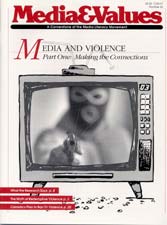Making Connections: Media's Role in our Culture of Violence
|
This article originally appeared in Issue# 62
|
We must not overlook the powerful potential of media literacy skills to reduce the impact and challenge the influence of violence in our media and popular culture.
When Deborah Prothrow-Stith, M.D., dean of Harvard University's School of Public Health, begins one of her eloquent speeches on the growing crisis of violence as a public health issue in society, she often recounts the story of a young gunshot victim being treated in a Boston hospital emergency room. He expressed surprise that his wound actually hurt.
"I thought, boy, he's really stupid, anybody knows that if you get shot, it's going to hurt. But it dawned on me that what he sees on television is that when the superhero gets shot in the arm, he uses that arm to hold onto a truck going 85 miles an hour around a corner. He overcomes the driver and shoots a couple of hundred people while he's at it."
Facing the Facts
For decades, media writers, directors and producers have been trying to tell us that the violent content of the media they create also doesn't hurt, that is, that despite its glamour and impact, it plays no role in making this a more violent society.
They may have had a case earlier in this century when portrayals of media violence were less believable but today the proliferation of realistic-looking mayhem, assualt and death makes for a totally different situation. One expert believes that of the 25,000 murders committed in the United States every year (the greatest number of any industrialized country), at least half are due to the influence and desensitizing effects of media violence. At minimum, media violence may be most influential in modeling the use of deadly force as the primary, if not the only, way to solve problems and resolve interpersonal conflict.
Many blame media for the rise in violence, but of course that's not the whole story. It's also clear that overcrowding, pervasive life-long poverty, hunger, joblessness and drug addiction -- as well as the ready availability of guns -- also contribute to our skyrocketing homicide rate. But the media connection can no longer be ignored.
Some of the details of this connection might be questioned. Maybe the numbers could be debated. But the fact that a connection exists is hard to dispute. Which leads us to an inescapable conclusion: Something must be done.
For years, like other communicators, I believed that tolerating some things I didn't like in media -- including depictions of violence&emdash;was the price we paid for a free and open public discourse.
Taking Action
Of course, our First Amendment protections are still important. But so are the thousands of lives being lost every year. The issue, I believe, is no longer one of protecting free speech but of protecting human life; it is not a question of censoring ideas but of changing behaviors that are endangering the health and safety of every citizen, young and old. If media is part of the problem, we think media literacy can contribute to the solution.
As American citizens, their Congressional representatives and the leaders of the media industry wrestle with the First Amendment issues involved in reducing the incidences of violence in public media, we must not overlook the powerful potential of media literacy education to reduce the impact and challenge the pervasiveness of violence in our media and popular culture.
There have been, unfortunately, few published resources available for the task of media literacy education on the theme of violence, whether for children or adults. Therefore, in 1993 at the Center for Media Literacy, we embarked on the development of a comprehensive community education resource package on media and violence to meet this need. Beyond Blame: Challenging Violence in the Media, is a multi-media package that includes a Leader's Guide with lesson plans and media literacy activities to use with children and young people as well as adults, plus a video to use for community education. This important teaching tool has been widely acclaimed as a valuable resource for teaching and learning about media violence.
The backbone of the Beyond Blame program are two issues of Media&Valueswhich explored the violence topic. The first issue focused primarily on "Making the Connections" between the violence on the screen and violence in the street. The second issue, subtitled "Searching for Solutions" explored the content of media violence, why the current rating system doesn't work and creative options for changing the climate for violence by both media producers and their audiences.
Working together, we can develop the strategies and tools necessary to change our culture of conflict into a culture of concern. If is possible – if we begin now.



